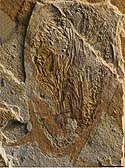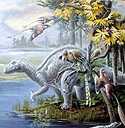| Location: Home > News > Events |
| ScienceWatch.com: Zhonghe Zhou talks about this month's Fast Moving Front in the field of Multidisciplinary |
|
The article is highly cited largely because there is such widespread interest in the exciting discoveries of exceptional fossils that have been made in the lacustrine Lower Cretaceous deposits of northeastern China. These finds have contributed significantly to shaping our views on the evolution of a number of important groups of animals and plants in the Mesozoic, such as feathered dinosaurs, early birds, mammals, and flowering plants. The paper provided a comprehensive summary of the discoveries that had been made up to 2003, and their evolutionary implications. The paper also gave an account of the geological background to the fossil finds, discussing such matters as the age of the deposits, the tectonic, paleogeographical, and paleoenvironmental setting in which the biota lived and evolved, and their exceptional preservation. Thus, it represented the first effort to understand these discoveries from a paleoecological perspective. In addition, the paper presented some original ideas such as the "cradle hypothesis," an explanation for the composition of the Jehol Biota, and basically dismissed the alternative "refugium of relics" hypothesis.
Finally, recent discoveries and studies have made research on the Jehol Biota into one of the fastest growing areas in paleontology, and one that has attracted not only paleontologists but also evolutionary biologists and geologists on a global scale.
The paper did not describe any newly discovered fossils. Rather, it presented a synthesis of extraordinary discoveries, mainly from the Early Cretaceous age of China, that have greatly increased our knowledge of the evolution of many biological groups such as birds, dinosaurs, mammals, and angiosperms. The paper also summarized what were then recent breakthroughs in the dating of the fossil-bearing deposits, an issue that was at one time highly controversial. Although no new methods were introduced in this paper, we did adopt a multidisciplinary approach that integrated many different aspects of what might be called Jehol studies. Bringing disparate lines of evidence together opened a new window on this terrestrial Early Cretaceous ecosystem.
In this paper, we argued that the Jehol Biota provided significant fossil evidence supporting both the hypothesis that birds evolved from among dinosaurs and the hypothesis that flight evolved "from the trees down"—in an arboreal environment, rather than a terrestrial one. Among the Jehol fossils, the most significant are probably the feathered dinosaurs, which are generally small and have a very close phylogenetic relationship with birds. We also discussed the significance of the associated early birds and mammals, and their implications for understanding the evolutionary history of these groups in the Cretaceous. Similarly, we explained how plants from the Jehol bridge chronological and evolutionary gaps between other Mesozoic plants and the modern flora. We concluded that the Jehol Biota indisputably belongs to the Early Cretaceous rather than the Late Jurassic, being approximately 120-125 million years old. The most unequivocal evidence for this comes from direct dating of the ashes interbedded with the fossil-bearing sediments. Based on these relatively solid radiometric dates, on biostratigraphic correlations of the Jehol fossils with those from other regions, and on Cretaceous paleogeography, we proposed that the Jehol Biota was an evolutionary "cradle" in which many major groups originated and diversified. We further suggested that the Jehol Group could be viewed as a window on an interesting case of faunal succession in an Early Cretaceous terrestrial biome, in which an established biota merged with and was partially replaced by a novel biota composed of both immigrants and new taxa that were evolving in situ.
I first got involved in the study of the Early Cretaceous vertebrates from the Jehol Biota in Liaoning in 1988, when I was working on my master`s thesis on a fossil fish. Extraordinary discoveries began to be reported from this region in the early 1990s, including early birds, feathered dinosaurs, pterosaurs, amphibians, primitive mammals, flowering plants, insects, and others. These finds have of course drawn enormous attention from among both scientists and the general public. Since the 1990s my focus has been on the study of early birds. I have also become involved in studies on feathered dinosaurs and pterosaurs, as well as the stratigraphy of the fossil-bearing sediments. These diverse projects have helped me to acquire a more comprehensive understanding of the Jehol Biota.
In late 2001, I was invited to write a review article for Nature on the Jehol Biota together with Paul Barrett, a dinosaur expert at the National History Museum of London, and the paleobotanist Jason Hilton, a Senior Lecturer in Palaeobiology at the University of Birmingham. The 2003 paper was the result of that invitation. I did not encounter any particular problems while we were working together on this research, and in fact my colleagues` expertise on dinosaurs, plants, and paleogeography dovetailed nicely with my own research interests. It was a collaborative project in the best and most satisfying sense of the term.
Study of the Early Cretaceous Jehol Biota is entering a new era. Many Jehol taxa have already been named and described. Exciting discoveries are still being made, and are rounding out our understanding of the biodiversity of this Lower Cretaceous terrestrial ecosystem. However, we are now reaching a stage where we can revisit some of the previously described species and evaluate them in more detail, in order to learn more about their implications for the evolution of Cretaceous vertebrates in general. The transition from non-avian theropods to birds is a good example. In recent studies dealing with this transition, attention has shifted to tracing the complex distribution of characters and character transformations among advanced theropods. New pieces of evidence in support of both the terrestrial and the arboreal hypotheses for the origin of bird flight have been revealed, and this is probably telling us that the evolution of flight was a complex process possibly incorporating elements of both scenarios. The idea of a simple dichotomy between the terrestrial and arboreal alternatives is looking increasingly outdated, and the new focus should be on reconstructing the detailed anatomical and functional changes that took place at each stage of a continuous transition from flightless theropods to early birds. Paleoenvironmental studies hold the key to a successful reconstruction of the paleoecosystem. A more complete geochronological and paleomagnetic framework is essential for understanding the relationship between the evolution of the Jehol Biota and its paleoenvironmental context. More reliable and extensive biostratigraphic correlations between the Jehol Biota from northeastern China and its counterparts in other regions can provide more information on the origins and radiations of major biological groups. The interactions among various groups of animals and plants represent another important topic that merits further discussion. Geochemistry is expected to play a key role in interpreting the actual paleoenvironments that the biota inhabited. Finally, it is well known that the Early Cretaceous was a time of frequent volcanism and strong tectonic activity, as well as a global warming trend that reached its climax in the middle of the Cretaceous. The relationship between the origin and evolution of the Jehol Biota and these major global and regional geological events needs careful investigation, and the Jehol has the potential to be a central case study for the effect of geological and climatic events on Cretaceous ecosystems.
Unfortunately, I do not think this research has any remarkable social and political implications. The paper by Zhou et al. (2003) did touch on collection strategies and some associated problems, which probably has led to more international awareness of the widespread illegal collecting, fakery, and smuggling that plague Chinese paleontology. However, raising awareness is not the same thing as finding solutions to these problems, which of course was well beyond the scope of the research. I think the paper did show how critical new fossil evidence can demonstrate the tremendous explanatory power of evolutionary theory, which is, unfortunately, often challenged by creationists even today. Zhonghe Zhou, Ph.D. |
||||||||||||||||||||||||



